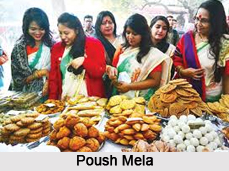 Fairs and Festivals of Vishva Bharati University include Poush Mela, Sriniketan Utsav, Ananda Bazar, Rathindra Mela and Nandan Mela. Visva-Bharati University is a major Central Government funded autonomous university located in Shantiniketan in Birbhum District of West Bengal. This University firmly believes the ideology of Rabindranath Tagore. Rabindranath Tagore believed in open air education and had reservations about any teaching done within four walls. This was due to his belief that walls represent conditioning of mind. Rabindranath Tagore did not have a good opinion about the Western method of education introduced by the British Government in India. Rabindranath Tagore also believed that the fairs and festivals will unite India to a greater level and it has a direct connection with the rural and urban economics.
Fairs and Festivals of Vishva Bharati University include Poush Mela, Sriniketan Utsav, Ananda Bazar, Rathindra Mela and Nandan Mela. Visva-Bharati University is a major Central Government funded autonomous university located in Shantiniketan in Birbhum District of West Bengal. This University firmly believes the ideology of Rabindranath Tagore. Rabindranath Tagore believed in open air education and had reservations about any teaching done within four walls. This was due to his belief that walls represent conditioning of mind. Rabindranath Tagore did not have a good opinion about the Western method of education introduced by the British Government in India. Rabindranath Tagore also believed that the fairs and festivals will unite India to a greater level and it has a direct connection with the rural and urban economics.
Pous Mela
Poush Mela is an annual fair and festival that takes place in Shantiniketan, in Birbhum District of West Bengal. It is marking the harvest season. Poush Mela generally commences on the 7th day of the month of Poush, the fair officially lasts for three days.
Sriniketan Utsav
In the year 1922, Rabindranath Tagore established Sriniketan - the rural centre for folk culture and cultivation of rural activities, near Shantiniketan. On 6th February, to mark the foundation day of Sriniketan, the festival of folk culture organized the tribal dance of rural Bengal. The tribal dancers performed beautiful dance programmers.
Ananda Bazar
It is a small fair held at Gourprangan by students and the management of Vishwa Bharati University on the day of Mahalaya. The University of Vishwa Bharati closes down for the autumn recess.
Rathindra Mela
The students of Palli Samgathana Vibhaga organize Rathindra Mela. This festival marks the birth anniversary of Rathindranath, the poet`s son with a small mela held in Sriniketan.
Nandan Mela
This is an innovative art fair held before the birthday of Nandalal Bose. The works of art by students and teachers of Kala Bhavana are available here at affordable prices.
Basanta Utsav
Basanta Utsav is identified with Doljatra or Holi. This festival is organized by Vishwa Bharati University which is held on the grounds in front of Patha Bhavana. Patha Bhavana is not only the oldest school of the university but also the oldest institution on which the university was subsequently built during British era. It is the university school of Shantiniketan. Initially it was called Ashram Vidyalaya. It was later called Shantiniketan Vidyalaya, which was started by Gurudev Rabindranath Tagore.



















